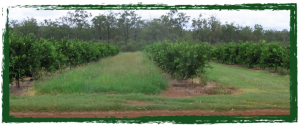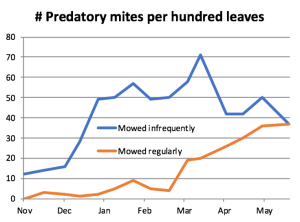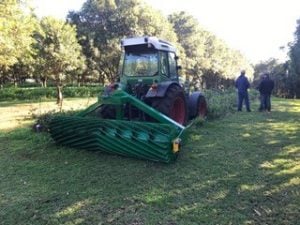Cover cropping (or vegetation in orchard inter-rows) helps to increase soil organic matter, improve soil structure, combat soil compaction and improve nutrient availability. Cover crops can also support integrated pest management in orchards as they provide pollen (food) and habitat for natural predators and parasitoids. A mixed species inter-row sward will provide some diversity of shelter and food for predatory insects in the orchard.
Mowing every second row ensures there is a refuge for beneficial insects to shelter in. Every few weeks (or when required) the alternate rows can be mown, again allowing beneficial insects to survive, whilst keeping the weeds or cover crop under control. Research in the citrus industry has highlighted how less frequent mowing supports higher population of predatory mites (Figure 1).


Figure 1. Encouraging growth of grass in the inter-row of citrus orchards can increase the populations of predatory mites. (Source: Dan Papacek, Bugs for Bugs)
In Europe, mowers that have side arms only to mow directly under the canopy, leaving the inter-row long, are becoming increasing popular due to the benefits of cover cropping. Crimpers are also available that ‘crimp’ the vegetation to make it lies down flat and start the process of mulching the plant matter back into the soil are also becoming an attractive choice for growers looking to increase their organic matter in the soil (Figure 2).

Figure 2: Crimper that ‘crimps’ the plants to start the process of mulching (Photo: M Veens)
Cover crops can also reduce weed populations, therefore reducing the reliance on chemical sprays during the season. Having a vegetation in the inter-row will also reduce issues with dust, which can reduce the occurrence of mites within the orchard.
It is also important to consider the pest host status of any broadleaf species in grass swards. For example, clovers may be useful for nitrogen fixation and release, but could pose a risk as a host of native moth pests including Light Brown Apple Moth. Consult your seed supplier for IPM suitable sward seed mixes. See also our article on broadleaf weeds: Broad -Leaved Weeds Support Orchard Pests.
Further Information
Establishing Cover Crops in Utah, USA. http://www.intermountainfruit.org/orchard-floor/cover-crops
Article Reviewed by Kevin Dodds (NSW DPI)
